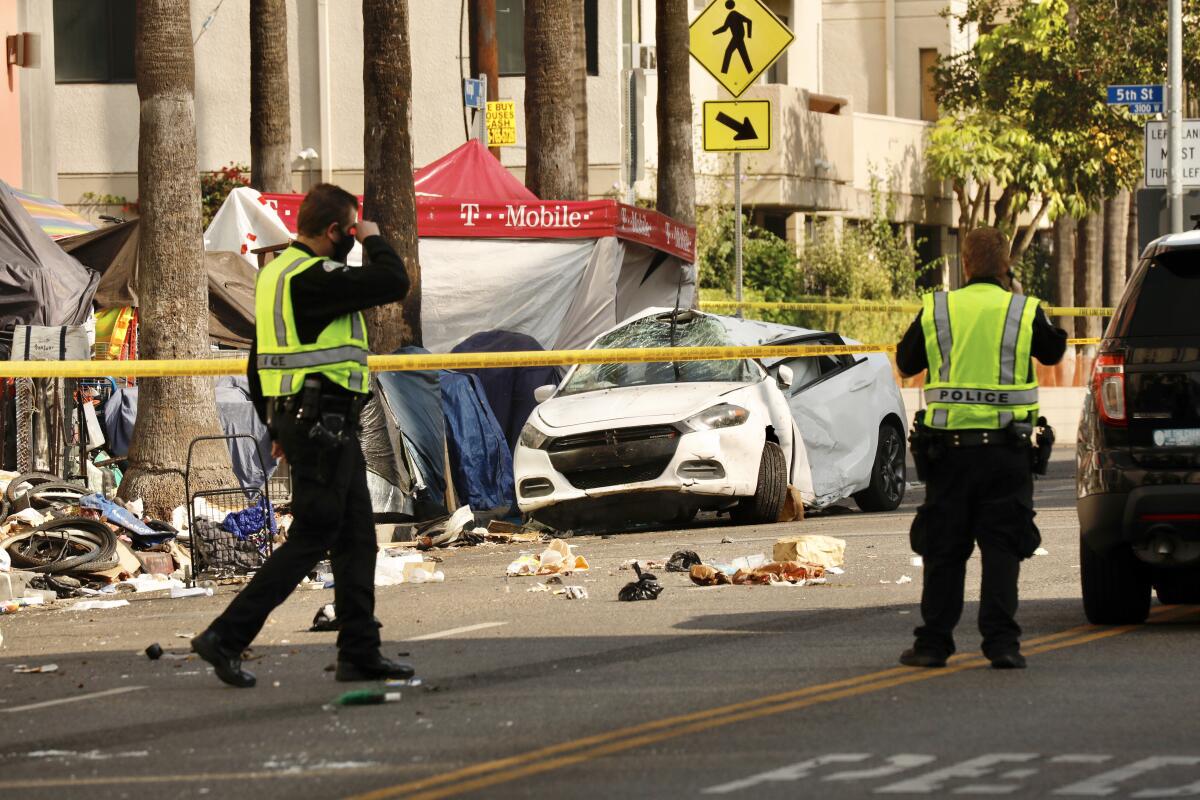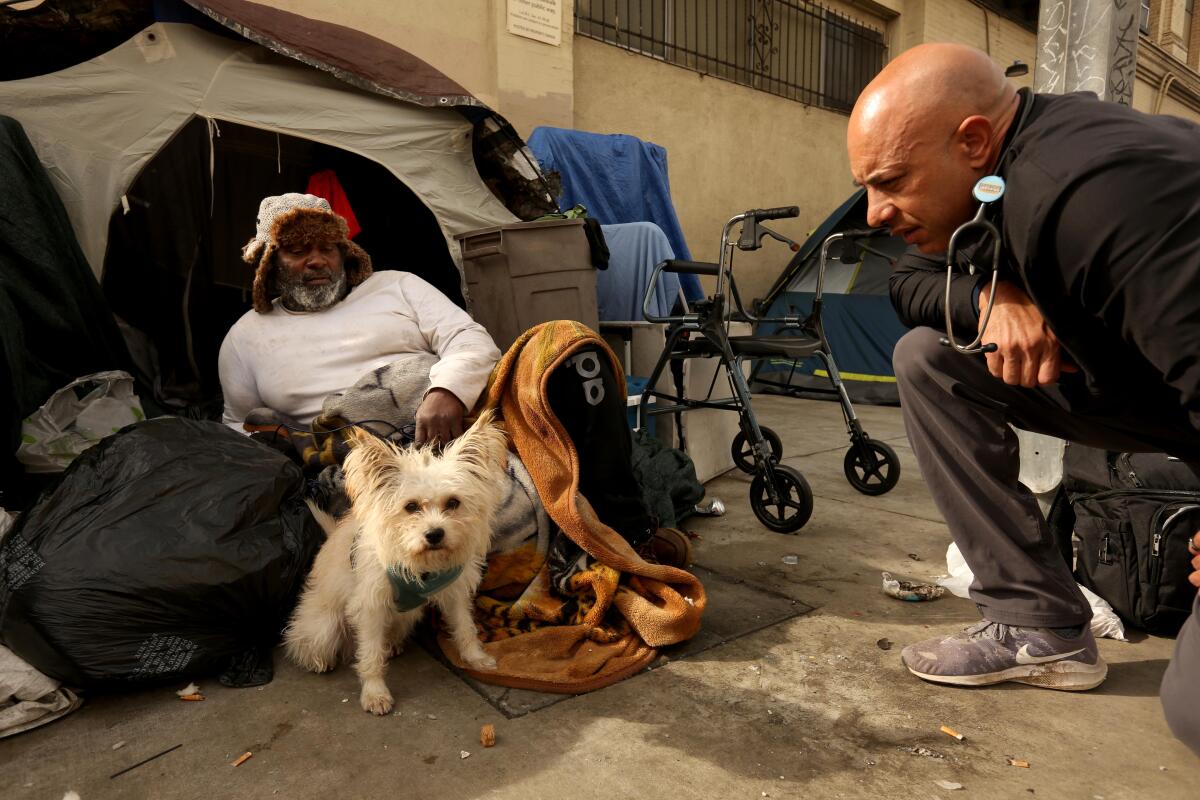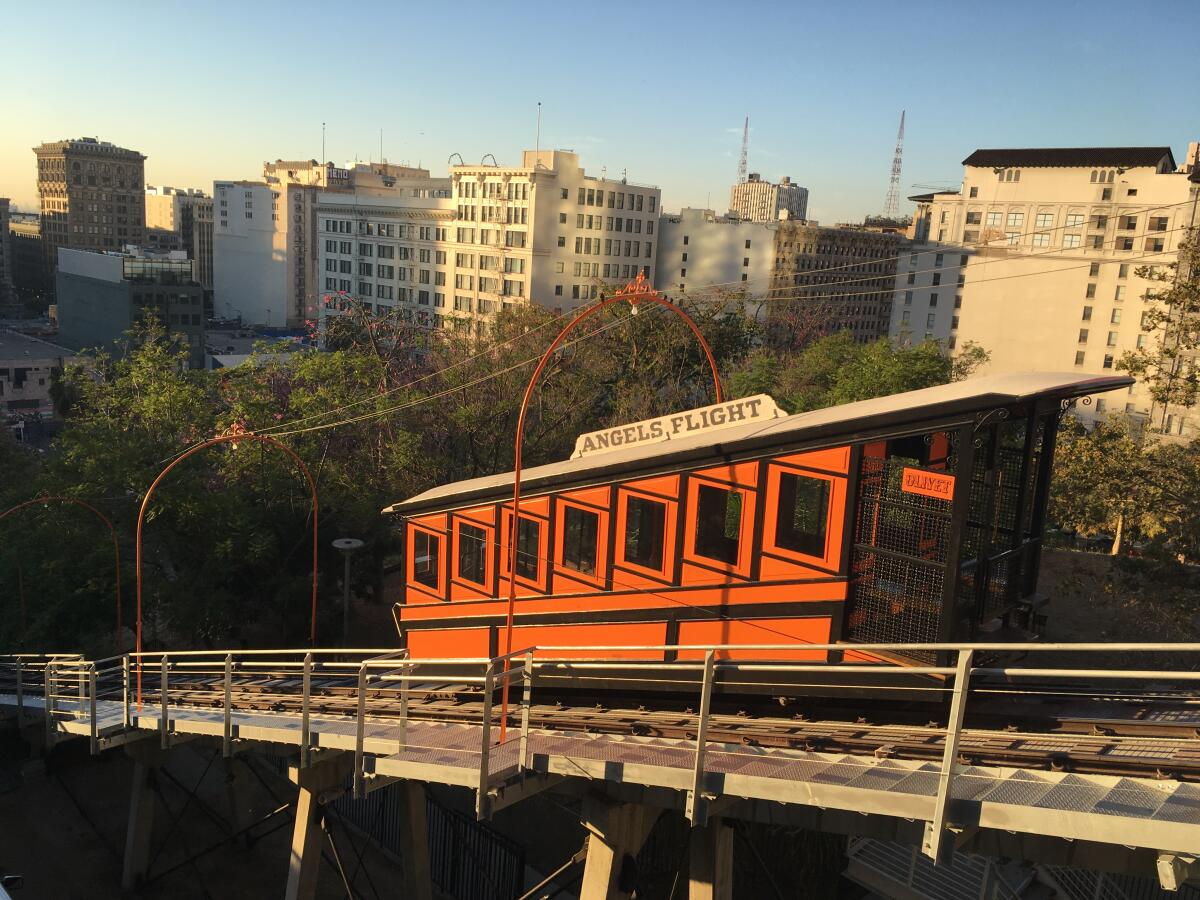Traffic violence continues to surge in L.A. Why can’t (or won’t) we make streets safer?

Good morning, and welcome to the Essential California newsletter. It’s Thursday, Jan. 19.
Last year in Los Angeles, more people were killed by someone driving a car than by someone wielding a gun. The second-largest U.S. city has become the traffic violence capital of the nation.
Traffic violence has surged in recent years on city streets. Preliminary city data show 312 people were killed in traffic crashes in 2022, the highest annual death toll in 20 years.
Fatalities rose 5% from 2021, previously the deadliest year on record. The number of traffic deaths increased nearly 30% from 2020. More than 1,500 people were severely injured in crashes last year, up more than 30% over two years.
Of those killed in crashes, about half ‚ÄĒ 159 people ‚ÄĒ were pedestrians struck by car drivers. Twenty people riding bikes were killed by drivers, up more than 30% over two years. More than 130 other cyclists were seriously injured.
New York City, with more than double L.A.‚Äôs population, not only had fewer traffic deaths per capita last year, but also fewer deaths overall than L.A. ‚ÄĒ 247, according to that city‚Äôs data.
This surge in traffic violence is happening despite city leaders enacting a plan to make streets safer. In 2015, then-Mayor Eric Garcetti launched a program called Vision Zero, with the stated goal of eliminating all traffic deaths on city streets by 2025.
It’s not working. In the seven years since then, traffic deaths are up nearly 68% overall. The number of pedestrians killed by drivers has skyrocketed by 80%.
‚ÄúTraffic violence is a public safety and health emergency that today claims as many lives in Los Angeles as gang violence,‚ÄĚ Connie Llanos, interim general manager for the L.A. Department of Transportation, said in a statement. ‚ÄúNo one should accept this.‚ÄĚ
At the state level, California typically leads the nation in traffic deaths, though Texas is close, with Florida not too far behind. The largest share of fatal crashes happen in Southern California counties, with the most victims in L.A. County, followed by San Bernardino, Riverside, San Diego and Orange counties, according to state data compiled by UC Berkeley.
Statewide data for 2022 have not been finalized, but the most recent five years of collision data show that nearly 3,600 people are killed in traffic crashes each year on average.
‚ÄúNearly 10% of all traffic deaths nationwide occur in California,‚ÄĚ said Tim Wiesberg, a spokesperson for the state‚Äôs Office of Traffic Safety (OTS). ‚ÄúThis can‚Äôt be acceptable. It can‚Äôt be a part of doing business or the status quo.‚ÄĚ
For comparison, a Boeing 747 can seat around 300 passengers. If a dozen passenger jets were crashing and burning across the state every year, imagine the national media attention and government investigations. We’d think twice about flying anywhere. There would be a large-scale effort to stop planes from crashing. But nearly 10 people killed on average every day while walking, rolling and driving in California? Well, that’s just how it is.
And that‚Äôs how it is because that‚Äôs how we, as a society, allow it to be. I use the word ‚Äúallow‚ÄĚ because other countries (and even some U.S. cities) have taken meaningful action.
So why don’t we? Why does the car, after more than a century of innovation, continue to be such a reliable instrument of death?
Safety experts I’ve spoken to in recent years point to several key factors:
1. People are driving too fast ‚ÄĒ and higher speeds lead to more violent, deadly crashes. In the early days of the pandemic, fewer people out on the road meant emptier streets, which some drivers took as an invitation to drive faster and more recklessly.
2. More distractions in our cars, less attention on the road. Cellphones and increasingly intricate in-car displays don’t make for safe driving. Our understanding of just how big a role distracted driving has in crashes is limited. The data on file is considered by many safety officials to be a serious undercount, as it relies on drivers admitting they were distracted or someone else witnessing a driver using their phone or other screen before a crash.
3. The way cities design and manage their streets can either discourage or enable dangerous driving. In L.A. ‚ÄĒ as in much of the U.S. ‚ÄĒ streets have historically been built to move as many cars as possible, as fast as possible.
‚ÄúIf you can slow down cars, it‚Äôs just simple science ... if there is a crash, [it will] be less severe if the car is not speeding,‚ÄĚ Weisberg explained. ‚ÄúWhen it comes to bicycle and pedestrian deaths ‚ÄĒ and just a lot of deaths in general ‚ÄĒ it continues to be speeding and impairment that are the main factors.‚ÄĚ
4. More of us are driving bigger cars. Nationally, sales and leases for trucks and SUVs rose sharply in recent years (minus a pandemic dip) as those for regular passenger vehicles fell. The larger the vehicle, the more dangerous they are for pedestrians.
‚ÄúWhen they hit a pedestrian, it‚Äôs on the upper part of their body, because they‚Äôre bigger vehicles, which increases the chances of injury,‚ÄĚ Weisberg said.
5. Systemic inequity has led to disproportionate deaths and injuries in Black and brown communities. Weisberg noted ‚Äúconcerning‚ÄĚ findings that show residents in historically neglected communities are disproportionately killed by drivers. He added:
‚ÄúThe reality is, not everyone drives ‚ÄĒ even in car-centric L.A. There are communities and minority groups and underserved populations that have been disproportionately impacted by traffic deaths. They‚Äôre the ones that maybe walk or bike or use transit. But they‚Äôre around built environments with a lot of cars ‚ÄĒ and speeding cars.‚ÄĚ
A 2020 study from UCLA found that 1 in 4 people killed in a crash over a five-year period in L.A. was either a Black or Latino pedestrian. The why isn‚Äôt a mystery. Many predominantly Black and brown neighborhoods lack the safety infrastructure ‚ÄĒ things such as crosswalks, traffic signals and safety lighting ‚ÄĒ afforded to more affluent parts of cities. L.A. is not unique in this.
‚ÄúIt‚Äôs troubling that somebody could walk out the door and they‚Äôre never going to come back,‚ÄĚ Weisberg said. ‚ÄúSimply for walking.‚ÄĚ
And as L.A.’s data show, more people are now killed and injured outside cars than inside them. Nationwide, pedestrian deaths reached a four-decade high in 2021, but the toll could be even higher once all the 2022 data come in.
It can be all too easy to see those numbers and miss the people those data represent. But sit for a moment and I’m sure you’ll think of someone you know who was killed or badly injured in a car crash.
I think of the grandfather and uncle I never met. In May 1979, my mom’s older brother was in the passenger seat when the driver lost control and struck a tree, causing the car to explode. My paternal grandfather died in a crash in August 1981 that nearly killed my grandmother as well. She needed walking aids and lived the rest of her life in chronic pain.
I think of kids I knew from middle school who were standing at an intersection near the local skatepark, waiting to use a crosswalk. A violent multi-vehicle crash propelled a car onto the sidewalk, striking them. They survived, but one boy lost part of his leg.
I think of a classmate from high school who never reached his 19th birthday. I think of my first journalism professor from community college, who died in a crash shortly after I transferred to Cal State Northridge.
Who do you think of? Were the crashes that hurt or killed them inevitable? How many deaths should we consider acceptable as part of our car-centric way of life? For a growing number of cities around the world, the number they’re working toward is zero.
Elsewhere in the world ‚ÄĒ and in some U.S. cities ‚ÄĒ an array of tools and strategies have been proved to reduce crashes and save lives. But progress depends on a multitude of factors, including political will, driver accountability, public outreach and stronger safety regulations for automakers. In many states and cities, that work is not happening at scale.
I‚Äôll explore some of those success stories ‚ÄĒ and why L.A. and other cities have failed make streets safer ‚ÄĒ in tomorrow‚Äôs edition of Essential California.
And now, here’s what’s happening across California:
Note: Some of the sites we link to may limit the number of stories you can access without subscribing.
L.A. STORIES
Hey, Angelenos, want to find ways to get involved in your neighborhood and community? Check out Shape Your L.A., the Times‚Äô new civic engagement tool. It‚Äôs designed to help you and fellow county residents understand how government handles the issues you care about ‚ÄĒ and how to get stuff done. Here are five ways to use it. Los Angeles Times
Check out "The Times" podcast for essential news and more
These days, waking up to current events can be, well, daunting. If you‚Äôre seeking a more balanced news diet, ‚ÄúThe Times‚ÄĚ podcast is for you. Gustavo Arellano, along with a diverse set of reporters from the award-winning L.A. Times newsroom, delivers the most interesting stories from the Los Angeles Times every Monday, Wednesday and Friday. Listen and subscribe wherever you get your podcasts.
POLITICS AND GOVERNMENT
L.A.‚Äôs school board has a new president, but she‚Äôs a familiar face. Jackie Goldberg served as the Los Angeles Board of Education president 40 years ago (and also held seats on the L.A. City Council and in the state Legislature). She told The Times she‚Äôll work ‚Äúto recover the losses of academic achievement‚ÄĚ among LAUSD students. Los Angeles Times
A new report indicates that a recent state law meant to create more duplexes has done little to encourage construction in some of California‚Äôs largest cities. Researchers found projects filed through the law, which took effect at the start of 2022, were ‚Äúlimited or nonexistent‚ÄĚ in cities including Anaheim, Bakersfield, Berkeley, Danville, Los Angeles, Sacramento and San Diego. Los Angeles Times
CRIME, COURTS AND POLICING
Thieves are targeting California’s refund cards. Some Californians who received their grants in the form of a prepaid debit card distributed by the Money Network say their card accounts were drained by fraudsters after they started using it. Here’s what to watch for. Los Angeles Times
A federal lawsuit filed against Disneyland alleges that cast members laughed just before a disabled woman was injured on the park’s Jungle Cruise ride. The Ventura County resident was hospitalized, later contracted an infection and died of septic shock. The lawsuit alleges it was her initial injury at the Anaheim theme park that led to her death. Los Angeles Times
Support our journalism
HEALTH AND THE ENVIRONMENT
California‚Äôs severe winter storms are a reminder that catastrophic flood danger is rising and the state is unprepared. Times reporter Ian James writes that ‚Äúthe latest science shows that the coming megafloods, intensified by climate change, will be much bigger and more destructive than anything the state or the country has ever seen.‚ÄĚ Los Angeles Times
Downtown San Francisco is struggling to bounce back from pandemic-fueled population losses. A new study of cellphone data showed the area has less than a third of the activity it did in 2019. San Francisco Chronicle
CALIFORNIA CULTURE

A San Diego veterinarian is on a mission to treat some of the region’s most cherished residents: pets living on the streets. About twice a month, Dr. Kwane Stewart visits homeless encampments in San Diego, Orange and Los Angeles counties, looking to provide free medical care to the animals of unhoused people. Los Angeles Times
Free online games
Get our free daily crossword puzzle, sudoku, word search and arcade games in our new game center at latimes.com/games.
CALIFORNIA ALMANAC
Los Angeles: mostly sunny, 57. San Diego: partly sunny, 57. San Francisco: becoming sunny, 54. San Jose: mostly sunny, 52. Fresno: chance of showers and patchy fog, then partly sunny, 50. Sacramento: becoming sunny, 51.
AND FINALLY
Today’s landmark love comes from Mark Turner all the way from Barcelona: Angels Flight Railway in downtown Los Angeles.

Mark writes:
‚ÄúAngels Flight is an iconic landmark and closely tied to the history and development of downtown Los Angeles. It has suffered a somewhat chequered history since its inception at the turn of the 20th century, but somehow still seems to provide a fitting connection between the modern California Plaza and the equally iconic Grand Central Market. A very welcome alternative to the stairs after a good lunch. Since reading Michael Connelly‚Äôs ‚ÄúAngels Flight‚ÄĚ book years ago, I was intrigued by the description of this funicular and it was on my bucket list of transport systems around the world on which to travel.‚ÄĚ
What are California‚Äôs essential landmarks? Fill out this form to send us your photos of a special spot in California ‚ÄĒ natural or human-made. Tell us why it‚Äôs interesting and what makes it a symbol of life in the Golden State. Please be sure to include only photos taken directly by you. Your submission could be featured in a future edition of the newsletter.
Please let us know what we can do to make this newsletter more useful to you. Send comments to [email protected].
Sign up for Essential California
The most important California stories and recommendations in your inbox every morning.
You may occasionally receive promotional content from the Los Angeles Times.




